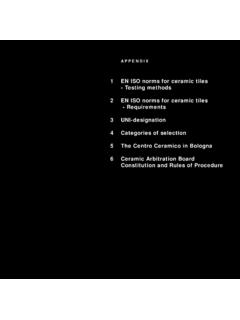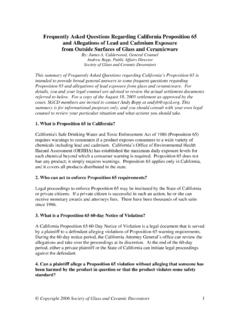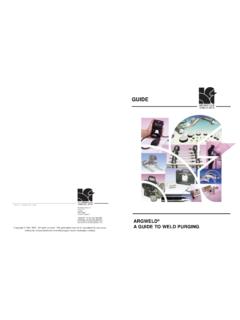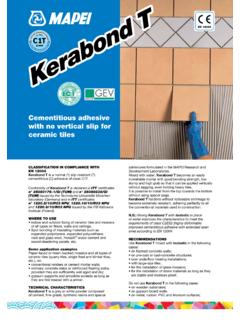Transcription of CERAMIC TILE UNDERLAY - BGC Innova™ Design
1 1 //JANUARY // TILE UNDERLAYFLOORING SUBSTRATE2 // distribution network ensures that our entire product range is readily available in all states of Australia and in New Zealand. BGC has a team of technical specialists that can assist with all specification and Design information to help ensure that you always build it better with BGC .BGC HAS INTERESTS IN/ Residential and commercial building / Building and construction products / Contract mining / Civil engineering construction and maintenance / Quarrying / Road transport / Property ownership and management / InsuranceOur mission at BGC is simple we want to ensure that people can always build it better with BGC . In keeping with our mission, we are constantly assessing and improving our products to ensure that we always provide cost effective, high quality and easy-to-use products to the &MISSION3 //HISTORY &MISSIONCONTENTS5 // PRODUCT DESCRIPTION5 // PRODUCT INFORMATION 5 // SHEET SIZE AND WEIGHT 5 // SHEET TOLERANCES 5 // FIRE RESISTANCE 5 // QUALITY SYSTEMS 6 // HANDLING AND STORAGE 6 // MAINTENANCE6 // HEALTH AND SAFETY6 // CUTTING AND DRILLING 7 // PREPARATION7-8 // SHEET LAYOUT8 // FIXING 9 // CONTROL JOINTS 10 // WET AREAS 11 // WARRANTY11 // TERMS AND CONDITIONS 4 // TILE UNDERLAY IS A SPECIALLY-FORMULATED FIBRE CEMENT SHEET.
2 IT S DESIGNED AS A STABLE SUBSTRATE FOR SLATE AND CERAMIC FLOOR TILES, SO YOU CAN INSTALL CERAMIC TILE FLOOR UNDERLAY OVER NEW OR EXISTING TIMBER FLOORBOARDS, PLYWOOD OR PARTICLEBOARD DRY AREAS, APPLY TILES DIRECTLY TO CERAMIC TILE FLOOR UNDERLAY FOR AN IMPERVIOUS, EASILY-CLEANED SURFACE. IN WET AREAS AND ANYWHERE SUBJECT TO ACCIDENTAL FLOODING OR WATERSPLASH, INSTALL A WATERPROOF MEMBRANE BE-TWEEN THE UNDERLAY AND YOUR TILE UNDERLAY // Specially-manufactured fibre cement sheet// Excellent substrate for floor tiles, both slate and CERAMIC // For dry and wet areas (see above)// Can be applied to both new and existing timber floorboards, plywood or particleboardFLOORING SUBSTRATECERAMIC TILE UNDERLAY5 //PRODUCT DESCRIPTIONPRODUCT INFORMATIONSHEET SIZE AND WEIGHTC eramic Tile UNDERLAY is a specially formulated fibre cement sheet designed to provide a stable substrate for slate and CERAMIC floor tiles.
3 It can be installed over new or existing timber floorboards, plywood or particleboard dry areas, tiling may be applied directly to the CERAMIC Tile UNDERLAY to form an impervious, easily cleaned surface. For wet areas, and areas subject to accidental flooding or water splash, the installation of a waterproof membrane between the CERAMIC Tile UNDERLAY and the tiling is required. CERAMIC Tile UNDERLAY is manufactured from cement, finely ground silica, cellulose fibres and water. It is cured in a high-pressure steam autoclave to create a durable, dimensionally stable Tile UNDERLAY is manufactured to comply with the requirements of AS Cellulose Cement Products. It is classified as a Type B Category 2 sheet and is suitable for internal are based on Equilibrium Moisture ContentSHEET TOLERANCESFIRE RESISTANCEQUALITY SYSTEMSC eramic Tile UNDERLAY complies with the requirements of Tile UNDERLAY has been tested by the CSIRO Building, Construction and Engineering Division, in accordance with Australian Standard 1989.
4 See report number FNE 7524. This report deemed the following Early Fire Hazard Indices: Ignitability Index 0 Spread of Flame Index 0 Heat Evolved Index 0 Smoke Developed Index 0 ~ 1 CERAMIC Tile UNDERLAY sheets are manufactured under the rigorous Quality Management System of the International Standard ISO 9002:1994. THICKNESS (mm)6 WEIGHT kg/m2 WIDTH (mm) (mm) 1800 6 // Tile UNDERLAY sheets may be cut to size on site. If using power tools for cutting, drilling or sanding they must be fitted with appropriate dust collection devices or alternatively an approved (P1 or P2) dust mask shall be worn. It is recommended that work always be carried out in a well-ventilated most suitable cutting methods are: // DURABLADE 180mm diameter.
5 This unique cutting blade is ideal for cutting fibre cement. It can be fitted to a 185mm circular saw, ie. Makita or similar. Please ensure safe working practices when SCORE AND SNAP Score the sheet face 4 or 5 times with a score and snap knife. Snap the sheet upward for a clean HAND GUILLOTINE Cut on the off-cut side of the line to allow for the blade HAND SAWING The back of the CERAMIC Tile Floor UNDERLAY sheet should be supported close to the cut. A fine toothed saw and a quick jabbing action gives best results. Mark out the cut lines on the face side of the DRILLING Use normal high-speed drill bits. Do not use the drill s hammer function.
6 For small round holes such as floor drains and water pipes, a hole-saw is recommended. For other penetrations, drill a series of small holes around the perimeter of the cut-out. Tap out the waste piece from the sheet face with a hammer while supporting the underside of the opening to avoid damage. Clean rough edges with a Tile UNDERLAY is manufactured from cellulose fibre, finely ground sand, cement and additives. As manufactured the product will not release airborne dust. However, during drilling, cutting and sanding operations, cellulose fibres, silica and calcium silicate dust may be in fine silica dust is hazardous and prolonged exposure (usually over several years), may cause bronchitis, silicosis or cancer.
7 CERAMIC Tile UNDERLAY , when used in accordance with this literature, requires no direct maintenance. However, regular checks (at least annually) must be made of the tiling system to ensure it remains watertight. Any cracked or damaged tiles, tile grout, or sealants must be repaired immediately, grouted and sealed as for new work. Any grout or sealant that is missing, cracked or likely to allow leakage, must be raked out and restored to original cutting sheets, work in a well-ventilated area and minimise dust generation. If using power tools, wear an approved (P1 or P2) dust mask and safety glasses. These precautions are not necessary when stacking, unloading or handling fibre cement further information or a Material Safety Data Sheet contact the nearest BGC Fibre Cement Sales Office or go to AND STORAGECUTTING AND DRILLINGC eramic Tile UNDERLAY sheets must be stacked flat, up off the ground and supported on level bearers.
8 The sheets must be kept dry, preferably by being stored inside a building. When stored outdoors they must be protected from the weather. Care should be taken to avoid damage to the ends, edges and surfaces. Sheets must be dry prior to being fixed, or sealed. HEALTH AND SAFETYMAINTENANCEAVOID INHALING DUST7 //For a simple layout, place a run of sheets loosely across the area to be worked. The loose layout allows for sheet manipulation and adjustments that will enable the optimum cutting and jointing positions to be established. Sheet edges can be overlapped as required to mimic the location of more complex areas a scaled layout is recommended. Remove any existing floor covering. The floor should be substantially flat before installing the UNDERLAY .
9 If any floorboards are warped, cupped or misaligned, the entire floor should be coarse sanded. It is recommended that a competent tradesperson carry out the a good result it is essential that the floor structure is sound and not prevent joint movement or cracking, floors should not deflect more than 1/360 of their span under maximum Design flooring laid over joists at 400mm centres this is equivalent to a deflection of between the joists {400/360 = }.Any repairs required on existing floors must be completed prior to fixing the CERAMIC Tile problems include: // Loose floorboards re-nail as Broken or damaged floorboards Damaged or rotted timbers that will not hold nails or will allow movement floor must be free of dirt, dust and grease before commencing to install the of the CERAMIC Tile UNDERLAY sheets or tile laying must not commence until both the flooring and its supporting framework are 1 // SHEET LAYOUTC eramic Tile UNDERLAY sheets must be stacked flat, up off the ground and supported on level bearers.
10 The sheets must be kept dry, preferably by being stored inside a building. When stored outdoors they must be protected from the weather. Care should be taken to avoid damage to the ends, edges and surfaces. Sheets must be dry prior to being fixed, or sealed. UNDERLAY Sheet - Leave 3mm clearance at walls,cupboards UNDERLAY sheets on centre line of floorboardNote: UNDERLAY sheets to run perpendicular to floorboards. Staggerjoints in UNDERLAY sheets3mm gap at walls and vertical penetrationsPREPARATIONSHEET LAYOUT8 // the layout so that:// There are no narrow edge pieces (less than 200mm wide).// When installing over panel flooring such as plywood or particleboard, position the UNDERLAY joints so that they do not coincide with joints in the underlying When installing over floorboards, run the sheet length (1800mm direction) across to the run of the flooring.






